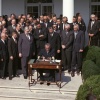In his latest book, Dinesh D’Souza offers a glimpse into a one-sided dialogue on both the merits of and the ideas behind conservatism. He does this by publishing his letters to a curious and interested college student named Chris—who is questioning his own politics and starting to form his own beliefs. These letters each cover one specific topic, many of the so-called “hot” ones—for instance, conservative as opposed to liberal, libertarian, political correctness, feminism, education, abortion, and everything in between.
While the book itself is “one sided”—we never see the “young conservative’s” letters—the dialogue is not. This is because the book prompts thoughts, opinions, questions, and concerns both by Chris and by the reader. It is, unquestionably, a much more interactive book than it appears at first glance.
As someone who both professionally and personally has a preference for the Socratic method of teaching, this book was intriguing from the outset. It offered a method of teaching about conservatism that I hoped would answer every conceivable question that I could come up with, and, even more important, that someone who was anti-conservative could come up with. Does it succeed? Mostly it does.
D’Souza does his best to leave no stone unturned. In fact, he offers his own background as illustration as well, not fearing to break down the barriers of personal privacy to make the logic of conservatism clear. As he points out, he did not start out as a conservative, which would make sense on the surface considering his own background. In truth, his first year on board he was considered a “moderating influence” on the conservative school paper, the Dartmouth Review.
Born in India, D’Souza arrived in the United States in 1978 as a Rotary Exchange student. His host family convinced him to apply to Dartmouth as one of the top schools, and the following fall he found himself about to discover snow. He spent a typical freshman year, planning to major in economics with a goal for further study in business. Since he enjoyed writing, he joined the campus newspaper, the Dartmouth. This decision ended up having a major impact on his life, for, toward the end of that first year, the editor came out of the closet—as a conservative. A major schism erupted, and when the editor was fired, he turned around and created a conservative rival, the newborn Dartmouth Review, modeled after William F. Buckley’s National Review.
Having practiced a liberal “go-with-the-flow” of unformed and uninformed opinions, D’Souza notes that his decision to join the Review was driven not by politics but by two other reasons: esthetics and intellectualism. He found a “style and a joie de vivre” that he had not found previously associated with conservatism, and he was greatly impressed by the “seriousness” of the conservative students, and their determination to debate the finer points—all night if need be. From this book, it is clear that D’Souza has not forgotten either of those two points himself.
In fact, that is what makes this book such a pleasure. Many people have tried to defend their political views before, both in spoken and in written words, but usually such attempts come off as sanctimonious and dogmatic. Rarely is it enjoyable, or even tolerable, to sit through such a lecture, except when earnestly trying to learn more about the person. In this case, though, D’Souza remembers that this book is ultimately not about him. It is about explaining an idea, a belief system. He remembers the first rule of mentoring—that to be a mentor is not to create a younger version of one’s self, but to nurture the young in their own potential. He practices this carefully, employing pragmatism, logic, and a subtle sense of humor. In the end, he ensures that the word conservative does not become obscured by the word I.
Unfortunately, though, D’Souza’s effort is not spotless. In the quest for brevity, he is often too brief. He does not take the time to explain some issues, particularly the complicated, multi-faceted issues, in the kind of detail they require. For example, he centers most of his argument against feminism on two points: the fact that the bell curve of female IQ is higher and taller than the male IQ bell curve (meaning that there are less female geniuses than male ones—and less idiots as well), and that feminism has turned against work from the home. He writes: “The feminist error was to embrace the value of the workplace as greater than the value of the home. Feminism has endorsed the public sphere as inherently more constitutive of women’s worth than the private sphere. Feminists have established as their criterion of success and self-worth an equal representation with men at the top of the career ladder. The consequence of this feminist scale of values is a terrible and unjust devaluation of women who work at home. This has been recognized. Less noticed has been the other equally unfair outcome: Women are now competing with men in a domain where, at the very top level, they are likely to lose” (105–106).
As a woman who also believes that contemporary feminism has wandered away its original mission, D’Souza’s chapter on feminism is unfortunately too short and likely to cause controversy. He does indeed have several good points. He is right that feminism has placed a higher value on careers in the workplace than careers in the home. The fact is that many of the women of my generation recognize this and have fought against it. We believe the key to feminism is empowering women to have the freedom to make any working choice—to work, to work part-time, or to stay at home. Many of the women in my generation do not see the “glass ceiling”; they do not even have one over their heads at all. If I may use anecdotal evidence, all of my female friends who work make more than my male friends of the same age.
But the most important point may be about the IQ bell curve. While IQ tests have shown to accurately predict academic achievement, they do not necessarily predict achievement in the real world. Just look at leadership experience and at D’Souza’s own commentary on our former president Ronald Reagan. As D’Souza points out, Reagan himself used to joke about his lack of intellectual prowess. Leadership is simply not something that can be accurately measured and it does not have any true ties to IQ, but leadership is something that has a very critical role to play in the business and political worlds. As a generation of women rises up through the ranks in business and politics, they are already succeeding and even more will succeed on a par with men. Their IQs simply do not matter. Leadership matters. That is why, in an area as complicated as feminism, in which many younger women call themselves “anti-feminists” or simply a new breed of feminists because they do not like to be associated with the old guard, D’Souza should have spent more time making his case before dismissing feminism so quickly.
Despite the occasional misstep resulting from trying to be too brief, this book is a truly valuable resource. I keep it nearby to remind myself of certain well-formulated arguments. It is a treasure of arguments and counter-arguments, including some useful information not only for those who are trying to evaluate conservatism, but also for those who are already conservative and even for those who are annoyed by their conservative cohorts. I know from personal experience that political beliefs are challenged and questioned by others every day, so it is a good idea to keep questioning one’s own self in order to stay sharp. After all, someone who knew something about the Socratic method did say that “an unexamined life is not worth living.” On the subject of conservatism, I have not found a better and equally succinct set of arguments.











